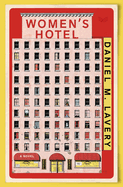
In Daniel M. Lavery's Women's Hotel, the Biedermeier, "which even in the grand old Art Deco days had failed to come out on the right side of the glamour line," is as much a character as the women who have made a home in her rooms. There's plain first-floor director Katherine, with her wholly unexpected past, and the beautiful Gia Kassab (third floor) with her "disarming honesty and singleness of purpose." Gia arrives with a fierce determination to marry the much older Douglas Burgess, an editor who once dated her mother. There's Kitty (first floor), who can "make the slightest inconveniences seem like a ruinous series of disasters," and the Society of Friends (11th floor): Carol, Patricia, and Sadie, a trio of artists whose overstuffed suite contrasts with the austere minimalism otherwise embraced.
With characteristic wit and a singular intelligence, Lavery (Something That May Shock and Discredit You) builds a thoroughly impressive first novel out of these women and their stories. On its face, each woman's small, tenuous life may seem insignificant, failing to make any lasting mark on the city she hopes to conquer; however, what Lavery's brilliant (and often very funny) book insists is that each woman's individual experience has value. Similarly, Lavery's cheeky author's note asserts the insignificance of women's hotels, which "sparked no consequent movement and left behind no organized legacy," but the novel itself undermines that insistence, proving the untold worth of these temporary havens, which offered women a blend of privacy and communal living and a refuge from any number of less-preferable situations. Readers will want to move right in. --Sara Beth West, freelance reviewer and librarian

